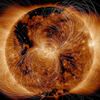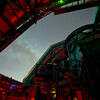You are here
Rosetta: the End of an Odyssey

Rosetta recently began the descent phase that will see it rejoining Philae on the surface of comet 67P/Churyumov-Gerasimenko on September 30.
Anny-Chantal Levasseur-Regourd:1 Yes, this is the final phase in a long journey that took it to the vicinity of the nucleusFermerthe solid part of a comet. Navigation has been extremely complex throughout the entire duration of the mission. In fact, it is impossible to orbit the nucleus of a comet, which, unlike a planet, has a very low mass and thus a very weak gravitational pull; nor is it possible to remain very close to the nucleus when the latter is highly active and emits gases and particles. When it was decided to end the Rosetta mission in this way, the preparatory phases began in order to ensure that the descent of the spacecraft would be optimal for both technical operations and pure science.
Although many talk of “collision,” it is in fact a controlled impact—a second landing—that will be almost as complex to perform as that of Philae in November 2014.
A-C L-R: Indeed, the speed of the Rosetta probe at the time of touchdown on the cometary nucleus could be around 50 cm/s (1.8 km/h), i.e., half that of Philae. At such low speeds, it is somewhat exaggerated to talk of ‘impact’ or ‘collision,’ even if Rosetta will not come through the experience unscathed. Given the extremely irregular surface of the comet, there will perhaps be some damage to the huge solar panels, and to the high-gain antenna—which in any case will no longer be directed towards Earth and thus no longer transmit. A soft landing perhaps, but one which nevertheless spells the end of the mission.
Was this ending intended from the start?
A-C L-R: The comet reached its perihelion—the point in its orbit nearest the Sun—on August 13, 2015, and since then has begun to move further away. During its long cruise towards the comet, Rosetta had to be placed in hibernation for some 30 months (June 2011-January 2014). It is a very “sustainable” probe that relies entirely on energy captured by its solar panels. The further away from the Sun, the less energy it receives.
At the moment, the energy absorbed is enough for operating it together with many of the on-board instruments. We therefore had two alternatives: a controlled descent to obtain as much information as possible at the end of the mission, or a further hibernation of about three years. But Rosetta has already carried out a great deal of work, and may not survive such a long period. Further, the hibernation solution would require a great deal of work at the European space operations center, entailing extremely high costs. This decision was completely consensual.
How was the landing zone selected?
A-C L-R: We are coming to know this comet so well now that the solution became fairly self-evident. The ideal region (called Ma’at) is on the small lobe—where Philae also landed—and is optimal, first in terms of the operational constraints of the descent and second in terms of its scientific potential. This region in fact contains numerous pit-like structures measuring around 100 meters in diameter and 50 meters deep; these pits, which may sometimes become active, are covered with strange hemispheric nodules, sometimes referred to as “goose bumps,” which could indicate aggregation mechanisms at work during the formation of comet nuclei.

Which instruments will be operational during this approach?
A-C L-R: All of them. Except, obviously, Philae, and perhaps MIDAS, which collects small dust particles but will have no time to analyze them using the on-board atomic force microscope.
There were many twists and turns to this mission even before it took off: the initial project was originally supposed to bring back samples.
A-C L-R: Indeed, the initial pre-project was a partnership between NASA and ESA to bring back to Earth samples from a comet that were as well-preserved as possible, i.e., at low temperature and with their porous structure intact. Yet this proved to be exceedingly complex and thus expensive, and NASA decided, entirely reasonably, to abandon the mission and concentrate on its own shorter missions such as Stardust, Deep Impact and EPOXI, which were extremely successful.
This resulted in major upheaval to the mission.
A-C L-R: Yes, and during several stages. The ESA plan was to carry on board two lander modules, Roland (Germany) and Champollion (US). When this US part of the project was abandoned, Rosetta was left with an empty carrying slot and certain experiments, such as CONSERT, part of which was on the American lander, could no longer be carried out. Thankfully, an agreement between Germany and France resulted in the upgrading of Roland into Philae, an absolutely exceptional creation. And NASA did not withdraw entirely from the mission, since it is responsible for three of the instruments on board Rosetta.
For you, and for many others, this is also a human adventure that has lasted over 20 years. You were one of the first people to work on the project.
A-C L-R: Yes, everything really began with a meeting held in Canterbury (UK) a few months after the Giotto probe performed a flyby of Halley’s Comet in March 1986. We already knew that such flybys would not be enough to learn everything, and we dreamed of a long-lasting rendezvous with a comet, to follow its development as it warmed up up as it approached the Sun, before cooling down again as it moved away from our star. This was a human adventure for many people, whether scientists, technicians or engineers, and in fact some of them who had retired in the meantime returned to take part in the Rosetta “wake-up” in January 2014. I will never forget this period in which Rosetta approached the comet, until almost reaching its orbit in early August 2014. And then there was the evening of November 12, 2014, when we understood that Philae had bounced, before inferring during the night that it had failed to reach escape velocity and that it had ultimately landed in an area with little sunlight, from which it was able to accomplish most of its mission until its batteries ran out completely. But what I found truly extraordinary was the enormous impact all of this adventure had on the general public.
What scientific lessons can we draw from the project today?
A-C L-R: There were three major types of result: images of the comet nucleus, confirmation of hypotheses, and unexpected discoveries. To begin with, the most spectacular results are the absolutely incredible landscapes obtained via the OSIRIS imaging system.
This is the first time that we have been able to observe a comet at such close range and over such a long period of time. And what did we see? This nucleus with its two lobes and an enormous variety of structures comparable to dunes, large boulders, and the practically circular pits we spoke of earlier. We also noted very smooth areas corresponding to regolithic deposits of fine dust and structures—cliffs—but which in reality consist of strata superimposed in terraces, possibly providing clues to the way in which the nuclei were formed.
Because there is talk of two objects that may have been joined together…
A-C L-R: Absolutely. When it was noticed that these terraces had specific orientations on each lobe, the existence of two independent nuclei that had gently collided was inferred. We can consider this to be a ‘ground truth’ for previous hypotheses.
And numerous other hypotheses have also been confirmed thanks to this mission.
A-C L-R: Yes. The Rosetta mission has confirmed many such hypotheses. Before the two lobes were joined, these subnuclei were formed through the aggregation of solid particles at low speed, as indicated in the images obtained by MIDAS. Further verification of earlier hypotheses was provided by the French CONSERT experiment, which showed a relatively homogeneous internal structure and determined its porosity. The mass was accurately measured, together with the shape—these were scientific firsts. The density was found to be 0.53 g/cm3 (in comparison, Earth density is 5.51g/cm³). For such an object made up of different types of dust and ice, this indicates an extremely high porosity, significantly above 70%.
And this density was important for the Philae landing phase.
A-C L-R: Yes. We were very lucky since the engineers who built Philae found it difficult to accept that the density of cometary nuclei could be below 1. Philae was actually designed to land on comet 46P/Wirtanen, but because of a problem with the Ariane launcher rocket in 2003, an other comet had to be found within Jupiter-family comets, 67P/Churyumov-Gerasimenko, which has a larger nucleus than Wirtanen, and therefore, with its density also below 1, a mass and thus a gravity that fit what Philae had been designed for.



Did you expect the comet to have this type of shape?
A-C L-R: It is not impossible that many comet nuclei have this same shape. The nucleus of 1P/Halley itself also seems to present two lobes. The flyby of 103P/Hartley2 revealed, with the American EPOXI mission, a shape resembling a dumbbell. Some asteroids also have this type of shape, so it was not really a great surprise.
What other important confirmations did the mission achieve?
A-C L-R: The composition of the main gases in the comaFermerthe vast halo surrounding the nucleus made up of gases arising from the sublimation of ice and of solid particles ejected with these gases, but also the most fascinating aspects of more refractory materials. The Stardust mission had collected samples at high speed from the coma of comet 81P/Wild 2, and the presence of glycine was strongly suspected. The COSIMA instrument onboard Rosetta confirmed its presence on a comet, and when we begin to look at amino acids…
… We are looking at the building blocks of life.
A-C L-R: Yes, building blocks, which while clearly not sufficient in themselves, were probably necessary for life to emerge. Here, we are starting to see a lot of evidence, which is overwhelming. And the structure of more or less compact aggregates, established by the COSIMA microscope and the MIDAS atomic force microscope, suggest that these materials could have survived their passage through the atmosphere. Comets may thus have carried (during the late heavy bombardment 4 billion years ago), either directly through impacts with Earth, or else indirectly through cometary dust injected into the interplanetary dust cloud, these ingredients potentially essential for the emergence of life. To this may be added another more unexpected discovery—amongst many others—namely the presence of molecular oxygen in a comet, which once again may help us better understand the origin of the Solar System.
While many speak of the “end” for Rosetta, you see this more as a prologue to a long story.
A-C L-R: Yes, it is the end of the mission, but the resulting scientific data cannot be analyzed at once. The teams deeply involved in the Rosetta mission have spent a great deal of time on ensuring its technical success, and they will now focus 100% on the scientific results. And as always with space exploration, it may be years before the most remarkable results are validated and ultimately emerge.
- 1. Emeritus professor at UPMC (Université Pierre et Marie Curie) and researcher at the Laboratoire atmosphères, milieux, observations spatiales (CNRS / UPMC / UVSQ).













